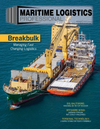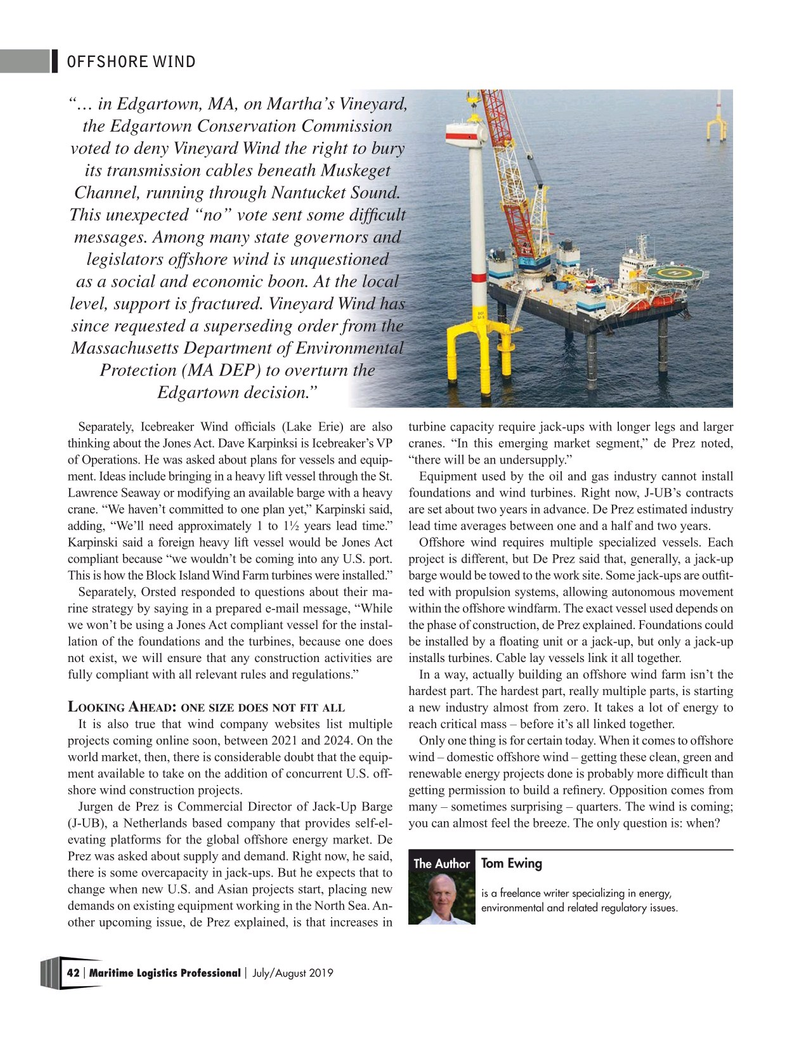
Page 42: of Maritime Logistics Professional Magazine (Jul/Aug 2019)
Breakbulk Issue
Read this page in Pdf, Flash or Html5 edition of Jul/Aug 2019 Maritime Logistics Professional Magazine
OFFSHORE WIND “… in Edgartown, MA, on Martha’s Vineyard, the Edgartown Conservation Commission voted to deny Vineyard Wind the right to bury its transmission cables beneath Muskeget
Channel, running through Nantucket Sound.
This unexpected “no” vote sent some dif? cult messages. Among many state governors and legislators offshore wind is unquestioned as a social and economic boon. At the local level, support is fractured. Vineyard Wind has since requested a superseding order from the
Massachusetts Department of Environmental
Protection (MA DEP) to overturn the
Edgartown decision.”
Separately, Icebreaker Wind of? cials (Lake Erie) are also turbine capacity require jack-ups with longer legs and larger thinking about the Jones Act. Dave Karpinksi is Icebreaker’s VP cranes. “In this emerging market segment,” de Prez noted, of Operations. He was asked about plans for vessels and equip- “there will be an undersupply.” ment. Ideas include bringing in a heavy lift vessel through the St. Equipment used by the oil and gas industry cannot install
Lawrence Seaway or modifying an available barge with a heavy foundations and wind turbines. Right now, J-UB’s contracts crane. “We haven’t committed to one plan yet,” Karpinski said, are set about two years in advance. De Prez estimated industry adding, “We’ll need approximately 1 to 1½ years lead time.” lead time averages between one and a half and two years.
Karpinski said a foreign heavy lift vessel would be Jones Act Offshore wind requires multiple specialized vessels. Each compliant because “we wouldn’t be coming into any U.S. port. project is different, but De Prez said that, generally, a jack-up
This is how the Block Island Wind Farm turbines were installed.” barge would be towed to the work site. Some jack-ups are out? t-
Separately, Orsted responded to questions about their ma- ted with propulsion systems, allowing autonomous movement rine strategy by saying in a prepared e-mail message, “While within the offshore windfarm. The exact vessel used depends on we won’t be using a Jones Act compliant vessel for the instal- the phase of construction, de Prez explained. Foundations could lation of the foundations and the turbines, because one does be installed by a ? oating unit or a jack-up, but only a jack-up not exist, we will ensure that any construction activities are installs turbines. Cable lay vessels link it all together.
fully compliant with all relevant rules and regulations.” In a way, actually building an offshore wind farm isn’t the hardest part. The hardest part, really multiple parts, is starting
L A : OOKING HEAD ONE SIZE DOES NOT FIT ALL a new industry almost from zero. It takes a lot of energy to
It is also true that wind company websites list multiple reach critical mass – before it’s all linked together.
projects coming online soon, between 2021 and 2024. On the Only one thing is for certain today. When it comes to offshore world market, then, there is considerable doubt that the equip- wind – domestic offshore wind – getting these clean, green and ment available to take on the addition of concurrent U.S. off- renewable energy projects done is probably more dif? cult than shore wind construction projects. getting permission to build a re? nery. Opposition comes from
Jurgen de Prez is Commercial Director of Jack-Up Barge many – sometimes surprising – quarters. The wind is coming; (J-UB), a Netherlands based company that provides self-el- you can almost feel the breeze. The only question is: when?
evating platforms for the global offshore energy market. De
Prez was asked about supply and demand. Right now, he said,
Tom Ewing
The Author there is some overcapacity in jack-ups. But he expects that to change when new U.S. and Asian projects start, placing new is a freelance writer specializing in energy, demands on existing equipment working in the North Sea. An- environmental and related regulatory issues.
other upcoming issue, de Prez explained, is that increases in 42 Maritime Logistics Professional July/August 2019 | |

 41
41

 43
43
